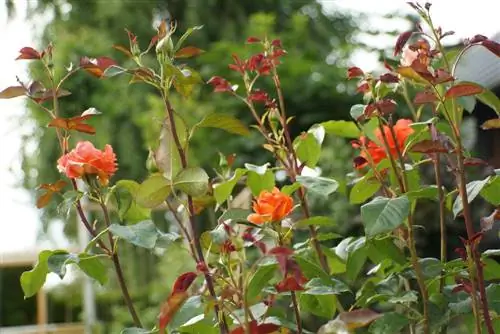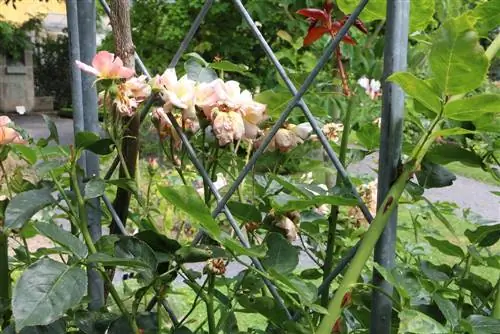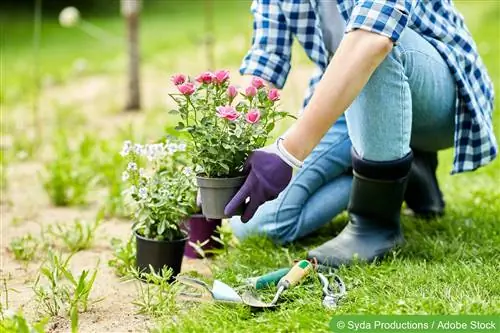- Author admin [email protected].
- Public 2023-12-17 03:39.
- Last modified 2025-06-01 06:48.
Transplanting roses is not a problem - if it is a young rose. It can be a problem with older roses, especially if the rose hasn't paid any attention to the rules of root growth. In the instructions you will learn how transplanting works, when to consider alternatives and what options you have if transplanting is quite risky due to the age/root shape of the rose.
Implementing roses profile
- Roses can (suddenly) be “out of place” for a variety of reasons
- Sometimes moving is unavoidable
- Sometimes you have to check whether other measures should be taken first
- Young roses up to the fifth season can usually be implemented without any problems
- Older roses are more delicate in this regard, especially if the taproot is injured
- Which doesn't have to go into the depths, but can grow horizontally through the ground
- It is difficult to predict how many roots an old rose will survive being transplanted
- Take as many intact old roots as possible
- And just to be on the safe side, pull a few clones from the pruning
Can the rose even be transplanted?
First of all, decide - if the analysis shows that the rose would not survive transplanting anyway, you don't need to waste any thought on new location, soil preparation, etc. Under the following conditions, you should forget about any thought about moving the rose as soon as possible:
Old Rose
It is an old, firmly established rose bush. With a rose, firmly established means that you are dealing with significant masses of roots. Roots that take surprising paths in the soil, as the following look at the “root development of the rose in theory and practice” makes clear:
If the rose grows according to the textbook, it develops a deep taproot that is surrounded by broad, fine roots. A young rose first develops fine roots so that it can feed itself from the substrate when the nutrient supply from the seedling is exhausted. Then the taproot is created, first very small and then deeper and stronger; surrounded by a few fine roots, which, if in doubt, start off into the distance when the conditions at the location change.
Practical experience reports, however, show that these fine roots do not have to remain fine and do not always start looking for food in the distance when the conditions at the location change. Sometimes they start immediately because the conditions nearby are better. They don't necessarily have deep roots, but can also discover the horizontal as rootable soil.
For example, a rose planted on a sunken terrace bed in deep layers of clay and gravel can very quickly (“with fine roots no. 1 - 17”) “smell” the better nutrient-supplied topsoil of the higher soil layer and head in that direction - the reporting hobby gardener dug up horizontal roots that were a good 6 m long. There are other reports of roses with horizontal spreading tendencies; and if the old rose roots properly into the depths, it will have already reached an interesting depth: When digging up an old rose, you can never be sure that you will get all the roots that the rose needs to continue living.
Tip:
If it turns out that an “attempt to move” is not worth it because the rose would hardly survive it, this realization is not always easy to accept. Is it really impossible to save your recently deceased grandma's favorite rose? Unfortunately, that may be the case because plants are not immortal either. But there is consolation: until the old rose bush runs out of life, you can still grow many, many small rose bushes from it. When you use cuttings, you create clones of the old rose, which is pretty close to immortality.
Sick Roses
If you want to move a rose because it has suffered from disease/pest infestation and the soil is contaminated - you should first check whether moving it really solves the problem. This is what happens when you kill the soil at the contaminated site with pesticides.
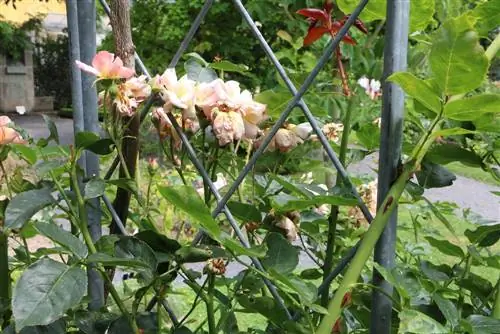
If you manage your garden without using toxic substances, you will certainly have tried to reduce pathogens/pest larvae to a tolerable level through suitable biological measures. Then you have usually also reduced the number of pathogens/pests in the soil to a tolerable level. Since pathogens and pests usually don't just colonize one place in the garden, you would also have to treat the new location prophylactically before moving the roses - then you can actually be confident that your measures will be effective at the given location, cut the rose back completely and everything else continue to grow at the old location.
Better treatment locally?
If you want to move a rose because it has almost died in a location with sufficient light - you should pause again for a moment to analyze the situation carefully:
There are situations in which your only choice is to transplant the rose or forget about it. When moving, the rose in the mortar bucket moves with it or not; after selling and building on one half of the property, the new neighbor would rather see lots of foreign exotic plants in his garden than old roses (and as a result of this first neighborhood dispute it turns out that he is allowed to remove the rose from his half); The soil has been contaminated with pollutants due to an accident, which requires soil replacement.
Other situations are less clear: If a rose is weakening in a given location, a soil analysis may be necessary first and then the soil in the old location should be improved. This is especially true if a soil sample from the planned new location has never been sent for analysis, i.e. other than the noticeable lighting conditions (which are actually sufficient for a rose at the old and new location) there is no information available that would indicate that the rose will be better at the new location. There are many other individual care measures that should be checked for correction before moving the rose. This is also because long-term incorrect care is not improved by transplanting the offspring.
However, if the rose is almost in the dark at its current location, moving it is definitely recommended. Then I would also like to give some advice to the rose gardener who planted the rose in this location: Please briefly inform them again about the basic needs of roses.
Preparing for transplanting
If the rose has to move, good preparation is the first prerequisite for success, and it works like this:
- Look for a new location that meets the rose's requirements (better than the old one)
- If possible, facing southeast or southwest
- In such locations the rose gets a lot of sun without burning in too much heat
- The location should be airy so that the leaves dry quickly after rain
- Prepare soil depending on the given nutrient content (and determined by soil analysis) and existing structure
- Loose compacted soil well
- Make soil that is too wet drier with sand
- If moisture keeps collecting, underline the soil with drainage
- Enrich nutrient-poor soil with nutrients
Tip:
Anyone who recommends soil analysis receives just as many annoyed groans as interested attention. Nevertheless, there is no way around it: no one would think of pouring any product of petroleum refining into the tank of their car; Rather, the already higher-quality product, gasoline, is subjected to precise analyzes before it is allowed to flow into the tank in the special form that suits the engine (regular gasoline, premium, unleaded, E 96). When it comes to the soil on your own doorstep, however, the suitability of the soil for feeding plants is rarely analyzed. Concentrated (compost, plant broths, etc.) and ultra-highly concentrated (synthetic liquid) fertilizers are applied “according to feeling”, which statistically results in over-fertilization and pollutes the groundwater.
The best time to transplant
Sometimes you have a choice when it comes to the time to implement, e.g. B. the rose should have a new place as part of the redesign of the garden.
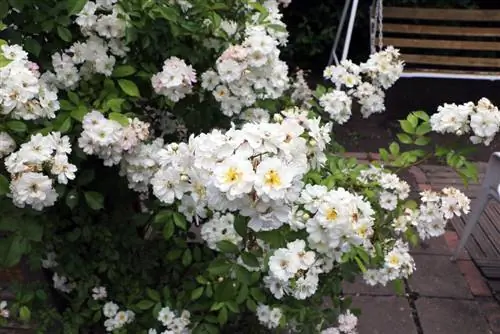
Then you should, if possible, move the rose in the autumn before the vegetation goes dormant (October and November). The growth in the upper area is complete, the plant can concentrate on growing the roots and establishing itself well over the winter (the roots continue to grow vigorously in the winter if they are not prevented from doing so by severe frost).
In principle, roses can be transplanted all year round as long as the ground is not frozen. You would have to do this, for example: For example, if you are moving in the winter, the rose may have to be moved into a mortar pot a few weeks in advance because the frost usually has its region firmly in its grip by the time of the move.
Implementing roses step by step
When the new location is ready, the rose can be transplanted. How to proceed:
1. Preparing rose for digging
As soon as the rose has lost its leaves in autumn, you can start.
You will make your work easier if you ensure a good view of the root area, which is achieved by cutting the rose back heavily (to around 40 cm).
2. Freeing rose bushes from old planting holes
Now the rose can be dug up, carefully (so that as few roots as possible are damaged) and with as many roots as possible.
With grafted roses, you should pay particular attention to the grafting area when digging it out, it is only about 5 cm below the ground and should under no circumstances be hit by a spade.
3. Prune roots + roses if necessary
All damaged, rotten, unhe althy, crooked growth etc. parts of the root are cut away.
Will the rose e.g. B. implemented at the old location due to waterlogging, there may not be much left of the root. Then the rose must also be adjusted to the existing rootstock at the top. Because root (nutrient absorption and transport unit) and shoot (nutrient-processing and therefore sprouting parts of the plant) function optimally in a precisely defined ratio (in the English-speaking world “root-shoot ratio”).
If this relationship is disturbed, help the plant cope with the disturbance by restoring it as best as possible through pruning.
4. Possibly expose roots
If the rose was infected by something that should not be moved to the new location, the root must be completely removed from the old soil and then washed/showered off. Stripping off soil and washing it off is best done with your hands and showering with a garden hose is fine as long as the hose still delivers warmed water.
If you just want the rose to move, move as much of the ball of soil around the root as possible with it. The more familiar soil microorganisms the rose has around it, the faster it will grow.
5. Dig out a planting hole
A core part of the work, the following paragraph probably persuades you to do a little more work in this regard:
- Dig the new planting hole generously
- It should be big enough for the roots to fit in without being kinked
- This means the horizontal and vertical extent
- This can cause quite a bit of digging
- Which directly helps the rose grow
Tip:
If the rose bush has been poorly looked after in its old location for a long time, you should give it a “strengthening infusion”: Mix a store-bought or self-made plant strengthener in maximum concentration, bathe the rose roots in it for an hour so that they are filled with nutrients can soak up.
6. Insert roses
Now the rose is placed in the new planting hole, straight please and if there is a grafting point, make sure that it sits approx. 5 cm below the ground again.
Press the soil down (add some more soil after a day or two if necessary) and moisten it well (=water it). In dry locations, pile up soil around the rose in a ring so that irrigation water is directed from the circular area directly to the roots will.
Fertilizer doesn't belong in the planting hole, it won't be available again until next spring and from then on at normal intervals.
7. Protect roses
Roses transplanted in winter are covered with pine branches; Roses transplanted in summer should be protected from strong sunlight during the growing phase.
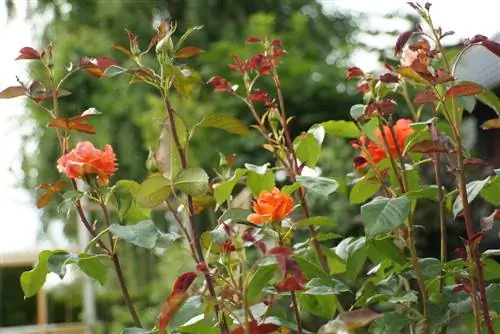
Tip:
If in doubt, digging up is also the time when you notice how firmly rooted an older rose is. If you dig into the ground with a spade and keep coming across thick roots, you should immediately dig a larger trench around the rose of the diameter that you are comfortable with digging. The thick roots are thinner there, so that only small wounds are created when cutting, which roses usually close without causing any damage. You then have to transport a massive rootstock, which works best with an old blanket and several helpers. If you can't find any end of a super thick main root, the rose either has to stay in place or this root has to be cut, in which case you should start a few cuttings from the pruning to be on the safe side.



